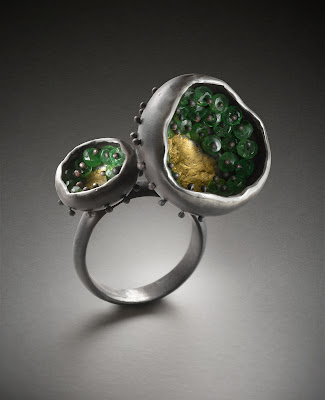Here it is, the third of my three posts about soldering. Are you ready to put the tips from my first two posts into action? If you haven't read them already I suggest that you read
Soldering Tips 1 and
Soldering Tips 2 before having a go at this tutorial, but I will take you through everything gently!
This tutorial will show you how to make an unusual toggle clasp - unusual in that the "bar" of the toggle is a daisy with a petal or leaf shaped ring for it to go through, rather than the more usual long bar through a decorated ring or donut of metal. I like my clasps to not look like clasps, as you will probably have noticed if you've visited my
Etsy shop!
Anyway, to get started....
You will need:
the basic soldering kit listed in
Soldering Tips 1 (although I didn't use third hand tweezers, binding wire or snips, so you can leave those out!)
small blow torch
easy and medium solder paste
chasing hammer
texturing hammer
saw and saw blades
needle file
wire cutters
round nosed pliers mandrel approx 16mm diameter
doming block and wooden punch
You will also need: approx 2cm square piece of 0.8mm sheet metal, 5cm 1.2mm wire and a scrap piece of 0.8mm wire. I have used sterling silver, but as you will see at the end of the tutorial this toggle works wonderfully with copper too.
And here's how to do it!
1. Saw a simple daisy shape from 0.8mm (20 gauge) sheet. My daisy has five petals and measures approximately 1.5cm in diameter. File to neaten the edges and hammer the flower to give it a texture.
2. Dome the daisy gently. I used the largest cup in my doming block and used a wooden punch to help protect the hammered texture.
3. Melt some scrap into a small ball and, when it has cooled down squeeze a small amount of medium solder paste onto the bottom of the ball - it is on there honest! You wouldn't believe the number of photos I took to try and get a decent view of the solder! If you need a reminder of how to melt scrap into a ball, have a look at my stud earrings tutorial
here.
4. Place the ball in the middle of the daisy and solder it in place. Remember that it is the heat of the metal that causes the solder to melt and flow, not the heat of the flame, and the daisy is a much larger piece of metal than the ball is. Heat the petals first, moving the flame in circles around the flower. As the metal takes on a dark reddish tinge (not bright red, that's getting too hot!) move the flame over the centre but keep it moving until the solder melts and flows. Quench, pickle and rinse the flower.
5. Form a small U from 0.8mm wire and place a tiny amount of easy solder onto each tip - again, it is there, honest!
6. Solder the U in place in the middle of the bottom of the daisy as shown, again remembering to heat the flower first as that's the bigger piece of metal. Use insulated reverse-action tweezers to hold the U in place and (this is the bit that takes the most practice) keep the U still while you remove the heat and the solder becomes solid again otherwise it could slip out of place.
7. Cut two 2.5cm lengths of 1.2mm (16 gauge) wire and bend them around a 16mm mandrel - I've used one of my wooden doming punches. You can see that I'm making lots of leaves at once here!
8. Place the pair of bent wires on a soldering brick to form a leaf or petal as shown.
9. Place a generous amount of easy solder paste at each tip. You have to be generous with the solder here as the joins aren't perfect - this is a rare time to ignore the rule that I gave in
Soldering Tips 2!
10. Heat the leaf to melt the solder. Keep the flame moving across the middle of the shape and move to each tip in turn as the metal starts to turn red.
11. Use the torch to direct the solder to where you want it to go. Remember that the solder will flow to the hottest part of the metal. In the case of the join I have circled I obviously had the left hotter than the right and so the solder flowed onto that side of the bottom join. I should have compensated by heating up the bottom right more until the solder flowed over there. I added a little more easy solder, heated again and got a good join second time around. Quench, pickle and rinse your work.
12. Hammer the leaf flat and give it a texture if you wish.
13. File the tips round and smooth, and give it a patina if you wish.
And there you have it! I have added a jump ring to both the daisy toggle and the leaf, and (because I can rarely make just one of any new clasp design!) I have made daisies with different textures, from silver and copper, and given some a lovely shine.
I hope that this tutorial, and my previous two posts, have inspired you to give soldering ago or to pick up your blow torch again. But if you are fan of toggle clasps without the time to make your own you can find the daisy toggles I have made here in my
Daisychain Extra etsy shop, and some of the other AJE team members have some beautiful toggle clasps in their shops too -
L to R:
Floral Toggle by Karen Totten,
Flower Burst Toggle by Kristi Bowman,
Moss Green Leaf Toggle by Lesley Watt
Jo Tinley
Daisychain Designs




















































